A Taste for Apples of Sodom Could Help Save Elephants
Impalas gorge on plants that would poison livestock. Photo Credit: Rob Pringle
The toxic chemical in S. campylacanthum is benign to these creatures. Pernicious compounds are common in bushes and shrubs, so “browsers” of branched plants have evolved to withstand eating the things “grazers” of grasses (which usually don’t contain such chemicals) cannot. What would spell famine for the domesticated ungulate brings a feast for many an untamed beast, as captured by camera footage from the researchers’ study
To understand the effects different species had on S. campylacanthum growth, the scientists fenced off separate areas of their study site in the Mpala Research Centre in central Kenya. Different types of barriers excluded particular animals. For five years, they recorded the S. campylacanthum consumption patterns in each one. They used field measurements and a model to demonstrate each animal’s influence on plant proliferation.
The native fauna limiting S. campylacanthum are a mark of the stabilizing mechanisms inherent in a mixed ecosystem. Diversity is key: Each plant-eating critter played a slightly different part in managing the noxious weed.
This discovery came about because the balance of that ecosystem is threatened. Overgrazing in Kenya’s fields has encouraged S. campylacanthum’s encroachment. Changing climate and increased farming activities have diminished access to well-watered lands for the country’s seven million pastoralists, leaving their livestock (numbering in the tens of millions, though precise counts are hard to come by) with smaller patches to roam. Pastures are chomped through with greater intensity, easing the way for invasive, inedible shrubs to take their place. “You end up with pastures choked with plants that are unusable,” Pringle told me, where sheep and cattle can no longer feed.
Even more troubling is the destruction of the wildlife that could check this imbalance, especially the killing of elephants.
There is some good news. In the past few years, local people have affirmed the mutual benefit between themselves and elephants that Pringle and his collaborators observe, and they are trying radical new protection efforts. Networks of community conservancies have sprung up, mostly with support from pastoralists

